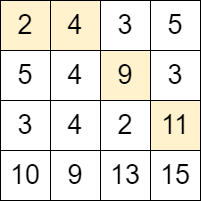2794. Maximum Number Of Moves In A Grid¶
Difficulty: Medium
LeetCode Problem View on GitHub
2794. Maximum Number of Moves in a Grid
Medium
You are given a 0-indexed m x n matrix grid consisting of positive integers.
You can start at any cell in the first column of the matrix, and traverse the grid in the following way:
- From a cell
(row, col), you can move to any of the cells:(row - 1, col + 1),(row, col + 1)and(row + 1, col + 1)such that the value of the cell you move to, should be strictly bigger than the value of the current cell.
Return the maximum number of moves that you can perform.
Example 1:

Input: grid = [[2,4,3,5],[5,4,9,3],[3,4,2,11],[10,9,13,15]] Output: 3 Explanation: We can start at the cell (0, 0) and make the following moves: - (0, 0) -> (0, 1). - (0, 1) -> (1, 2). - (1, 2) -> (2, 3). It can be shown that it is the maximum number of moves that can be made.
Example 2:
Input: grid = [[3,2,4],[2,1,9],[1,1,7]] Output: 0 Explanation: Starting from any cell in the first column we cannot perform any moves.
Constraints:
m == grid.lengthn == grid[i].length2 <= m, n <= 10004 <= m * n <= 1051 <= grid[i][j] <= 106
Solution¶
class Solution {
private int dp[][];
public int maxMoves(int[][] grid) {
int n = grid.length;
int m = grid[0].length;
dp = new int[n + 1][m + 1];
for (int current[] : dp) Arrays.fill(current, -1);
int maxi = 0;
for (int i = 0; i < n; i++) {
maxi = Math.max(maxi, solve(i, 0, grid));
}
return maxi;
}
private int solve(int row, int col, int grid[][]) {
if (row < 0 || col < 0 || row >= grid.length || col >= grid[0].length) return 0;
if (dp[row][col] != -1) return dp[row][col];
int op1 = 0, op2 = 0, op3 = 0;
if (row - 1 >= 0 && col + 1 < grid[0].length && grid[row - 1][col + 1] > grid[row][col]) {
op1 = 1 + solve(row - 1, col + 1, grid);
}
if (col + 1 < grid[0].length && grid[row][col + 1] > grid[row][col]) {
op2 = 1 + solve(row, col + 1, grid);
}
if (row + 1 < grid.length && col + 1 < grid[0].length && grid[row + 1][col + 1] > grid[row][col]) {
op3 = 1 + solve(row + 1, col + 1, grid);
}
return dp[row][col] = Math.max(op1, Math.max(op3, op2));
}
}
Complexity Analysis¶
- Time Complexity:
O(?) - Space Complexity:
O(?)
Approach¶
Detailed explanation of the approach will be added here